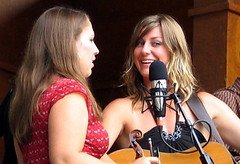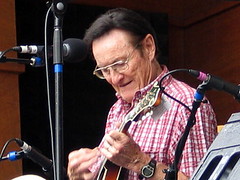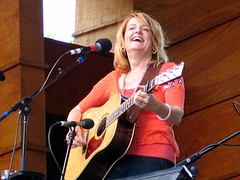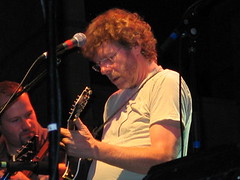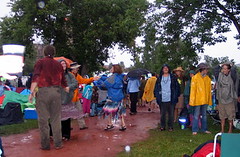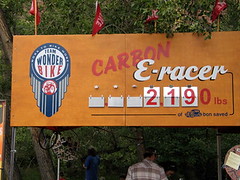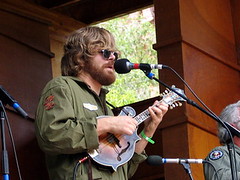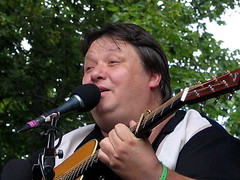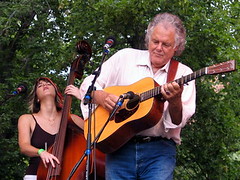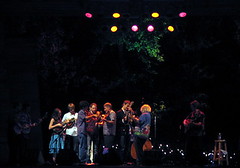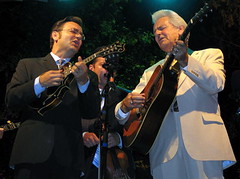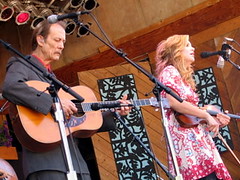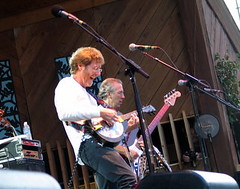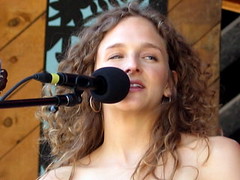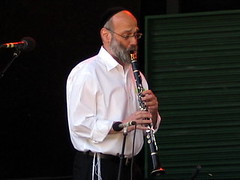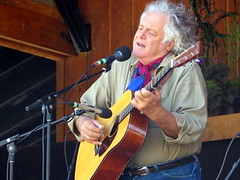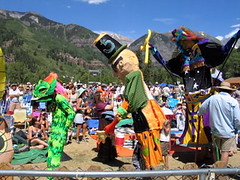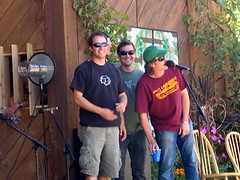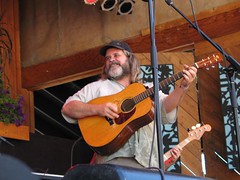 Grey Fox is not a festival for everyone. Let’s start by saying this thirty year old festival is one of the oldest and most respected events in the northeast, if not the country. It features one of the strongest lineups of any festival and enthusiastic participants return year after year, wait in line for up to a month, and create a large, boisterous, and fun-filled community on the top of the Hill from which they jam, party, socialize, and listen to great music.
Grey Fox is not a festival for everyone. Let’s start by saying this thirty year old festival is one of the oldest and most respected events in the northeast, if not the country. It features one of the strongest lineups of any festival and enthusiastic participants return year after year, wait in line for up to a month, and create a large, boisterous, and fun-filled community on the top of the Hill from which they jam, party, socialize, and listen to great music.
This year is no exception. Where else can you hear four days of Dry Branch Fire Squad? How about promised jams with The Infamous Stringdusters, Crooked Still, and the Duhks? (Well, it happened in April at Merlefest, but where else in the northeast?) The music is eclectic, featuring traditional bluegrass bands like James King, Doyle Lawson and Quicksilver, the Steep Canyon Rangers, and Michael Cleveland and Flamekeepers, Barefoot Bluegrass, and of course Dry Branch Fire Squad. For those who want to hear traditional bluegrass, Friday is the best day to attend.
A stronger element at this festival is the choice of progressive and innovative bands offered. The Waybacks, Infamous Stringdusters, Crooked Still, Uncle Earl, Duhks, Biscuit Burners, and The Greencards are just a sample of the superb new, young bands performing as individuals and in combination. Older performers who have led the way in making it possible for these bands to emerge include Sam Bush, Peter Rowan & Tony Rice, Mountain Heart, and more. Also included are bands more difficult to categorize like The Kruger Brothers, Marty Stuart & His Fabulous Superlatives, Danny Barnes, and Tony Trischka’s Double Banjo Spectacular. All in all, it’s difficult to find a place where you can hear more or better bands than Grey Fox, except…the hubbub, noise, and freedom of audience self-expression sometimes make it hard to hear and enjoy the music.
Getting a seat on The Hill is a problem for most people attending Grey Fox. A relatively large contingent begins arriving for this festival in late June. They set up camp in a field prepared for them just outside the main entrance starting in late June. By July 18th, when the gates open, there are hundreds of people in line to set up camp at the top of the hill. By July 18th, when the gates open, there are hundreds of people in line to set up camp at the top of the hill and claim preferred seating areas. These early liners are thus rewarded for waiting in line for weeks. (Note: A great way to gain access and to have a lot of privileges at this festival is to volunteer. Grey Fox volunteers are, appropriately, very well treated.) Last year we arrived in the line at about noon on Thursday and it took nearly three hours for us to move into the quiet camping area, which we preferred. The Hill itself is quite steep, so much so that the rear legs of seats must be dug in to permit flat seating. Festival rules call for low seats and low backs, but these rules are pretty much ignored, making it somewhat more difficult to see, although the steepness of the hill takes much of this problem out of play. Nevertheless, arriving early on the first day the gates were open and hurrying to the hill before even setting up camp, we only found space to place our chairs well behind the sound booth, about forty rows back.
a seat on The Hill is a problem for most people attending Grey Fox. A relatively large contingent begins arriving for this festival in late June. They set up camp in a field prepared for them just outside the main entrance starting in late June. By July 18th, when the gates open, there are hundreds of people in line to set up camp at the top of the hill. By July 18th, when the gates open, there are hundreds of people in line to set up camp at the top of the hill and claim preferred seating areas. These early liners are thus rewarded for waiting in line for weeks. (Note: A great way to gain access and to have a lot of privileges at this festival is to volunteer. Grey Fox volunteers are, appropriately, very well treated.) Last year we arrived in the line at about noon on Thursday and it took nearly three hours for us to move into the quiet camping area, which we preferred. The Hill itself is quite steep, so much so that the rear legs of seats must be dug in to permit flat seating. Festival rules call for low seats and low backs, but these rules are pretty much ignored, making it somewhat more difficult to see, although the steepness of the hill takes much of this problem out of play. Nevertheless, arriving early on the first day the gates were open and hurrying to the hill before even setting up camp, we only found space to place our chairs well behind the sound booth, about forty rows back.
Located on a rather steep hill that is usually farmed as a hay field, Grey Fox is wide open to the elements. Weather is a major factor in this festival almost every year, whether it rains or is clear and hot, the weather affects the experience more than it does many other festivals, even those others held in the open. When the sun shines hot, the hill can be dangerous. Attendees need to keep themselves covered and hydrated. Often hydration is accomplished through the consumption of copious amounts of beer carried in coolers to the performance area. The festival helps here by providing a misting tent, but there is no shade on the hill not provided by people who erect shelters. Rain is actually less of a problem than sunshine as its effects can be more easily mitigated.
Grey Fox web site and promotional materials talk about “The Grey Fox way.” The “Way” suggests a set of guidelines and principles for behavior, which can be lumped to gether into a sort of golden rule consideration. If these guidelines were followed, Grey Fox would be an ideal festival to attend for all. However, like the sixties communes on which many of these guidelines are based, the Grey Fox Way is adhered to where convenient and ignored whenever it gets in the way of an individual’s doing whatever he or she likes. We found that people shouting out requests and yelling drunkenly to each other in the audience, dancing in front of the stage, smoking tobacco and marijuana, and chatting incessantly rather than listening to the music trod unnecessarily on our enjoyment of the music. While I’m more tolerant of those differences than is Irene, nevertheless, we both deserve to have a full and fun experience.
gether into a sort of golden rule consideration. If these guidelines were followed, Grey Fox would be an ideal festival to attend for all. However, like the sixties communes on which many of these guidelines are based, the Grey Fox Way is adhered to where convenient and ignored whenever it gets in the way of an individual’s doing whatever he or she likes. We found that people shouting out requests and yelling drunkenly to each other in the audience, dancing in front of the stage, smoking tobacco and marijuana, and chatting incessantly rather than listening to the music trod unnecessarily on our enjoyment of the music. While I’m more tolerant of those differences than is Irene, nevertheless, we both deserve to have a full and fun experience.
Vendor’s row at Grey Fox is one of the largest and most diverse of any we see. The food is e xcellent and not too expensive, but you can still buy a funnel cake. Cash is not accepted at any vendor’s tent, but Grey Fox scrip is sold at a booth and can be redeemed at the end of the festival. People wishing to buy beer in vendor’s row must also get a proof of age wrist band attached. There is a good festival shopping on the hill, too with fine instruments, modish clothing, and stuff for kids. Cash is, as I remember, good at bands’ sales booths. A problem attendant to vendor’s row is the steady rumble that can be heard by spectators sitting on the right side of the sound booth. This steady, busy noise is distracting to wishing to concentrate on listening to the music.
xcellent and not too expensive, but you can still buy a funnel cake. Cash is not accepted at any vendor’s tent, but Grey Fox scrip is sold at a booth and can be redeemed at the end of the festival. People wishing to buy beer in vendor’s row must also get a proof of age wrist band attached. There is a good festival shopping on the hill, too with fine instruments, modish clothing, and stuff for kids. Cash is, as I remember, good at bands’ sales booths. A problem attendant to vendor’s row is the steady rumble that can be heard by spectators sitting on the right side of the sound booth. This steady, busy noise is distracting to wishing to concentrate on listening to the music.
Camping at Grey Fox is truly camping in the rough. There are no fixed facilities available. The festival provides trucks full of fresh water, which you may walk to to draw water and carry back to your campsite, (Perhaps this is why so much beer is consumed. It’s easier to carry to your campsite.) There is a place to take showers, which cost, I think, $5.00. There are three designated camping areas. The top of The Hill is a free for all camping area where people, many of whom have come to Grey Fox since the beginning, set up elaborate camping areas with kitchens, jamming areas, living quarters, and so-on. These compounds may accommodate twenty or more people, but are not walled off with tarps or wall hangings the way they are at Springfest. I understand that multi-story structures will not be permitted this year at Grey Fox. Jamming in this area is permitted 24 hours a day and the number and quality of these jam groups is very high. Below the performance stages is an area called Lower Camping area which has a time limit on jamming, but is still close to the action. About a quarter mile away, down the hill in a large meadow, is an even quieter camping area where little or no sound bleeds over from the sound stage, there is no j
carry back to your campsite, (Perhaps this is why so much beer is consumed. It’s easier to carry to your campsite.) There is a place to take showers, which cost, I think, $5.00. There are three designated camping areas. The top of The Hill is a free for all camping area where people, many of whom have come to Grey Fox since the beginning, set up elaborate camping areas with kitchens, jamming areas, living quarters, and so-on. These compounds may accommodate twenty or more people, but are not walled off with tarps or wall hangings the way they are at Springfest. I understand that multi-story structures will not be permitted this year at Grey Fox. Jamming in this area is permitted 24 hours a day and the number and quality of these jam groups is very high. Below the performance stages is an area called Lower Camping area which has a time limit on jamming, but is still close to the action. About a quarter mile away, down the hill in a large meadow, is an even quieter camping area where little or no sound bleeds over from the sound stage, there is no j amming, and it’s relatively easy to get a good night’s sleep. Regular bus transportation is provided from this area to The Hill. This area is also used as an overflow, so some people camping there are not so enthusiastic about maintaining the quiet, but they responded very cooperatively to a reminder one morning at 2:00 AM. The entire camping area provides very few level spaces. People planning on using some sort of RV should come equipped with plenty of boards and jacks to use for leveling their rigs. Grey Fox claims to limit camping tickets to 4,000 and I see no reason to doubt this, but this many camping units probably translate to more than 10,000 people. In addition, there are many day trippers.
amming, and it’s relatively easy to get a good night’s sleep. Regular bus transportation is provided from this area to The Hill. This area is also used as an overflow, so some people camping there are not so enthusiastic about maintaining the quiet, but they responded very cooperatively to a reminder one morning at 2:00 AM. The entire camping area provides very few level spaces. People planning on using some sort of RV should come equipped with plenty of boards and jacks to use for leveling their rigs. Grey Fox claims to limit camping tickets to 4,000 and I see no reason to doubt this, but this many camping units probably translate to more than 10,000 people. In addition, there are many day trippers.
Grey Fox has all sorts of other activities going on in addition to the music. Pete Wernick’s Jam Camp precedes the festival and his jam campers perform from the main stage on Thur sday afternoon. At the Masters stage a number of bands and performers talk about their art and give demonstrations. The Grass Roots tent offers clinics and workshops. Last year we attended workshops by Ron Thomason for beginning mandolin players and one by the legendary Bill Keith on banjo. There’s a dance pavilion where first rate bands play for dancers late into the night. This brings up the issue of dancing near the main stage. Since bluegrass in primarily a performance art, it isn’t really designed for dancing, yet many people can’t seem to sit still. W
sday afternoon. At the Masters stage a number of bands and performers talk about their art and give demonstrations. The Grass Roots tent offers clinics and workshops. Last year we attended workshops by Ron Thomason for beginning mandolin players and one by the legendary Bill Keith on banjo. There’s a dance pavilion where first rate bands play for dancers late into the night. This brings up the issue of dancing near the main stage. Since bluegrass in primarily a performance art, it isn’t really designed for dancing, yet many people can’t seem to sit still. W hile Grey Fox attempts to keep dancers from getting in front of watchers, they still can be a distraction. Because there is so much offered at the dance tent, it seems that those wanting to express their love for the music through movement could confine themselves to doing it at the dance tent. There’s a Family Stage where there are performances aimed at young people as well as a Bluegrass Academy for kids. In other words, there’s plenty to do and many choices to make at Grey Fox.
hile Grey Fox attempts to keep dancers from getting in front of watchers, they still can be a distraction. Because there is so much offered at the dance tent, it seems that those wanting to express their love for the music through movement could confine themselves to doing it at the dance tent. There’s a Family Stage where there are performances aimed at young people as well as a Bluegrass Academy for kids. In other words, there’s plenty to do and many choices to make at Grey Fox.
Having catalogued all the good stuff I have, why won’ t we be there? Too loud, too boisterous, too chemical induced, too noisy, too drunk, too much….The Hill. There are some bands that draw us to bluegrass festivals, but they aren’t at Grey Fox this year. Perhaps in another year, we’ll be back for a day or for the whole festival, but this year we’re staying home. That doesn’t mean you should. Perhaps the very issues I raised are the elements attracting you to a festival. We found our interactions with other attendees to be almost all positive, and there is a spirit that pervades this festival. We have spoken to other people, though, who don’t want to go back either as well as those who are highly enthusiastic. Give it a try.
t we be there? Too loud, too boisterous, too chemical induced, too noisy, too drunk, too much….The Hill. There are some bands that draw us to bluegrass festivals, but they aren’t at Grey Fox this year. Perhaps in another year, we’ll be back for a day or for the whole festival, but this year we’re staying home. That doesn’t mean you should. Perhaps the very issues I raised are the elements attracting you to a festival. We found our interactions with other attendees to be almost all positive, and there is a spirit that pervades this festival. We have spoken to other people, though, who don’t want to go back either as well as those who are highly enthusiastic. Give it a try.
Addendum: An anonymous commenter informs me that I'm mistaken about volunteers getting preference in seating, that they must wait for several hours after the gates open to put down their seats. I've made the appropriate changes in the text.


